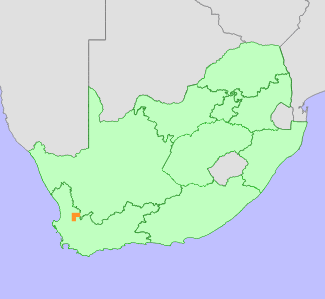|
Scientific Name | Paranomus tomentosus (E.Phillips & Hutch.) N.E.Br. |
Higher Classification | Dicotyledons |
Family | PROTEACEAE |
Synonyms | Nivenia tomentosa E.Phillips & Hutch. |
Common Names | Hairy-leaf Sceptre (e), Hairy-leaved Tree Sceptre (e), Harige Septerboom (a) |
National Status |
Status and Criteria | Near Threatened A2c; B1ab(iii)+2ab(iii) |
Assessment Date | 2020/05/18 |
Assessor(s) | A.G. Rebelo, H. Mtshali & L. von Staden |
Justification | Three out of five areas where Paranomus tomentosus was known from herbarium records in the northern extremes of this species' range could not be relocated during the Protea Atlas Project which was conducted between 1992 and 2002. The loss of these sites would mean a 55% reduction in the extent of occurrence (EOO). However, it is not known when or why these subpopulations disappeared, and they may have declined more than three generations ago. It is also unlikely that the subpopulations at these sites represented over 50% of the total population, as they are isolated sites at the extremes of the distribution range and were therefore probably smaller than the average subpopulation size.
Currently, Paranomus tomentosus has a limited distribution range, with an extent of occurrence (EOO) of 346 km², and an area of occupancy (AOO) of 136 km². It is known from 11-15 locations. Although this species habitat is protected, there is ongoing degradation of habitat due to presence of alien invasive plants. Furthermore the Protea Atlas Project noted unexplained population decline that indicate that 20-30% of the population declined in the past three generations (60 years). Therefore it nearly meets the thresholds for Vulnerable under criterion B and is listed as Near Threatened. |
Distribution |
Endemism | South African endemic |
Provincial distribution | Western Cape |
Range | Paranomus tomentosus is endemic to the Western Cape Province, South Africa, occurring in the Cederberg Mountains. |
Habitat and Ecology |
Major system | Terrestrial |
Major habitats | Cederberg Sandstone Fynbos |
Description | This species grows on rocky outcrops in sandstone fynbos, 1000-1500 m. Mature individuals are killed by fires, and only seeds survive. Seeds are released after ripening, and dispersed by ants to their underground nests, where they are protected from predation and fire. It is pollinated by insects. |
Threats |
| There has been population decline at three subpopulations in the past. Parts of the habitat was lost to crop cultivation on lower slopes. Remaining subpopulations however occur in nature reserves and in areas unsuited to cultivation, and this is unlikely to cause an ongoing decline. Overall, only 4% of this species' habitat is irreversibly modified. Currently, there are no severe threats to this species, but it is likely to be threatened by competition by alien invasive plants which are already present in low density and too frequent fires. Ongoing monitoring is needed, as drought-related mortality events are suspected. |
Population |
Three of the five known sites are extinct in the northernmost of range, and it is unknown whether the subpopulations were large or extensive. Scattered subpopulations remain along a 24 km long range, with the largest recorded subpopulations at Middleberg and Wolfberg. Unexplained population decline has been observed, and are suspected to be linked to climate change, with 20-30% of the population lost in the past 60 years (three generations). Ongoing monitoring of this species is needed.
|
Population trend | Decreasing |
Conservation |
| Most of the extant and extinct subpopulations lie within the Greater Cedarberg Wilderness Area. |
Assessment History |
Taxon assessed |
Status and Criteria |
Citation/Red List version | | Paranomus tomentosus (E.Phillips & Hutch.) N.E.Br. | NT A2c | Raimondo et al. (2009) | | Paranomus tomentosus (E.Phillips & Hutch.) N.E.Br. | Not Threatened | Hilton-Taylor (1996) | |
Bibliography |
Goldblatt, P. and Manning, J.C. 2000. Cape Plants: A conspectus of the Cape Flora of South Africa. Strelitzia 9. National Botanical Institute, Cape Town.
Hilton-Taylor, C. 1996. Red data list of southern African plants. Strelitzia 4. South African National Botanical Institute, Pretoria.
Manning, J.C. and Goldblatt, P. 2012. Plants of the Greater Cape Floristic Region 1: The Core Cape Flora. Strelitzia 29. South African National Biodiversity Institute, Pretoria.
Raimondo, D., von Staden, L., Foden, W., Victor, J.E., Helme, N.A., Turner, R.C., Kamundi, D.A. and Manyama, P.A. 2009. Red List of South African Plants. Strelitzia 25. South African National Biodiversity Institute, Pretoria.
Rebelo, T. 2001. Sasol Proteas: A field guide to the proteas of southern Africa. (2nd ed.). Fernwood Press, Vlaeberg, Cape Town.
|
Citation |
| Rebelo, A.G., Mtshali, H. & von Staden, L. 2020. Paranomus tomentosus (E.Phillips & Hutch.) N.E.Br. National Assessment: Red List of South African Plants version . Accessed on 2025/04/14 |
 Comment on this assessment
Comment on this assessment

